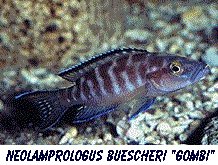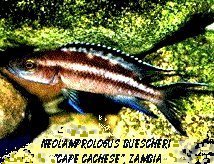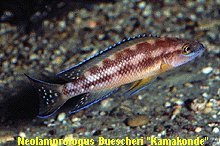
NAME.
| Neos | (Greek) meaning new, |
| lampros | (Greek) shining or gleaming |
| ogos | (Greek)-meaning eyes, referring to their brightly coloured eyes. buescheri - refers to the collector of the type specimen, Heinz Heinrich Buscher. |
| SYNONYM | Lamprologus buescheri |
DISTRIBUTION
First found at the southwest shore of Lake Tanganyika, Zambia. Cameron Bay, Cape Kachese to Chituta Bay. Local colour varieties known.
ECOLOGY
The species was discovered in the boulder and rocky areas of the lake at depths between 15 and 18 meters Neolamprologus buescheri lives in close contact with the rocks and immediately withdraws into crevices when disturbed. It is strictly territorial.

SHAPE COLOUR AND SIZE
Males grow to 8 cm, females to 6-7cm. The overall coloration of this species may be described as dirty beige overlaid by dark brown or black markings.
The fish has a very distinctive mustard-yellow eye socket.
Two prominent broad dark lines run horizontally along the length of the body. The upper stripe follows the contours of the dorsal fin and is broken in places whereas the lower complete and runs along the middle of the body.
Upper and lower edges of the caudal are covered with a thin ice blue border preceded by a wider dark brown/black band.
There is some iridescent blue speckling on the caudal. The anal is similarly coloured.
Has elongated slightly laterally compressed body and an extended forked caudal fin.
SEXUAL DIMORPHISM
There are no obvious external differences but during or prior to spawning the different vent shapes can be clearly observed. Genital papilla is larger in the male.
MAINTENANCE
Minimum tank size required for one pair is 30 inches. A small grain gravel substratum 1 inch deep topped by some coral gravel. Decor should consist of rocks arranged to provide several caves. Air driven undergravel filtration is sufficient, as the species does not dig. Lighting should be subdued.
Temperature 28oC pH 7·8 Hardness l8oGH
Water changes 20 % weekly
Neolamprologus buescheri will accept any foods it is offered e.g. flake, bloodworms, cockles and Daphnia.

BREEDING
As the species is quite un-sexable by external appearance the best way to obtain a pair is to start with six or more juveniles, growing them on together and allowing a pair to form naturally.
A pair will spawn in the correct conditions without needing a specific trigger such as a rise in temperature. The male's courtship ritual comprises of him darting back and forth in front of the female's cave with his fins erected; the female responds to this aggressively by lunging out at him. The spawning act usually takes place her cave early in the morning. About 20 white eggs are laid on the underside of the cave. Sometimes as few as ten eggs are laid. The male and female take turns to enter the cave despite there being ample room for the two, carrying out many dummy runs between each successful run. The eggs were observed to be laid in two distinct clumps each consisting of 8 or 9 eggs joined by a row of 6 or so individually spaced eggs; perhaps a way of ensuring that not all the eggs are lost to a predator during an attack. The female tends the eggs alone whilst the male guards the breeding territory very aggressively. The male is best removed to protect him from the females spirited defence of the clutch. Approximately 48 hours later the eggs disappear and no fry are to be seen. This can be very disheartening until about four days later when fry that are almost transparent, about 10- l4mm long, are observed tentatively leaving the confines of the cave. The female apart from keeping the fry within the breeding territory shows no particular parental care.
The larger fry have a carnivorous nature and being l7mm long and far bigger than their newly hatched siblings, practice cannibalism on the smaller fry. The solution to this is to remove the largest brood soon after the parent's spawn for the second time.
Text by Peter Turner